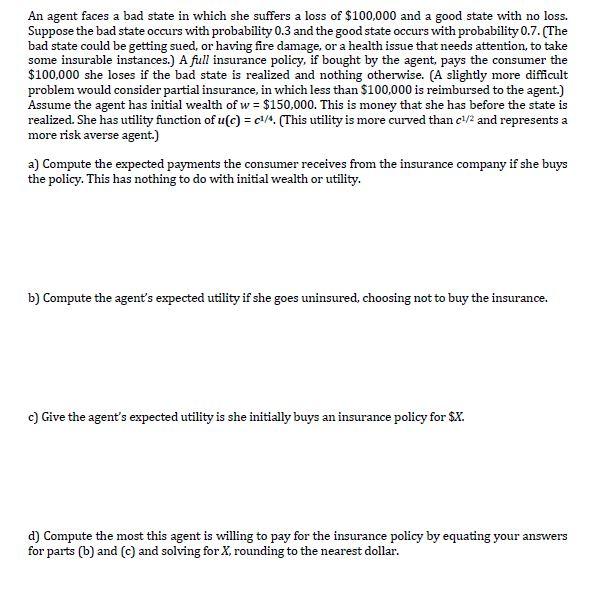
An agent faces a bad state in which she suffers a loss of $100,000 and a good state with no loss. Suppose the bad state occurs with probability 0.3 and the good state occurs with probability 0.7. (The bad state could be getting sued, or having fire damage, or a health issue that needs attention, to take some insurable instances.) A full insurance policy, if bought by the agent, pays the consumer the $100,000 she loses if the bad state is realized and nothing otherwise. (A slightly more difficult problem would consider partial insurance, in which less than $100,000 is reimbursed to the agent.) Assume the agent has initial wealth of w = $150,000. This is money that she has before the state is realized. She has utility function of u(c) = c1/4. (This utility is more curved than c1/2 and represents a more risk averse agent.) a) Compute the expected payments the consumer receives from the insurance company if she buys the policy. This has nothing to do with initial wealth or utility. b) Compute the agent's expected utility if she goes uninsured, choosing not to buy the insurance. c) Give the agent's expected utility is she initially buys an insurance policy for $X. ) Compute the most this agent is willing to pay for the insurance policy by equating your answers for parts (b) and (c) and solving for X, rounding to the nearest dollar. An agent faces a bad state in which she suffers a loss of $100,000 and a good state with no loss. Suppose the bad state occurs with probability 0.3 and the good state occurs with probability 0.7. (The bad state could be getting sued, or having fire damage, or a health issue that needs attention, to take some insurable instances.) A full insurance policy, if bought by the agent, pays the consumer the $100,000 she loses if the bad state is realized and nothing otherwise. (A slightly more difficult problem would consider partial insurance, in which less than $100,000 is reimbursed to the agent.) Assume the agent has initial wealth of w = $150,000. This is money that she has before the state is realized. She has utility function of u(c) = c1/4. (This utility is more curved than c1/2 and represents a more risk averse agent.) a) Compute the expected payments the consumer receives from the insurance company if she buys the policy. This has nothing to do with initial wealth or utility. b) Compute the agent's expected utility if she goes uninsured, choosing not to buy the insurance. c) Give the agent's expected utility is she initially buys an insurance policy for $X. ) Compute the most this agent is willing to pay for the insurance policy by equating your answers for parts (b) and (c) and solving for X, rounding to the nearest dollar







